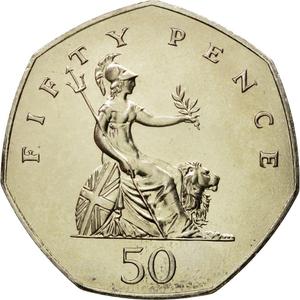The British fifty pence (50p) coin - often pronounced fifty pee - is a unit of currency equaling one half of a pound sterling. It is a seven-sided coin formed as an equilateral-curve heptagon, or Reuleaux polygon - a curve of constant width, meaning that the diameter is constant across any bisection. This shape, which was revolutionary at the time, made it easily distinguishable from round coins both by feel and by sight, while its constant breadth allowed it to roll in vending machines.
The denomination was introduced in October 1969 when the 50p joined the 5p (shilling) and 10p (florin) coins in circulation, leaving only the three copper coins (1/2p, 1p and 2p) to be introduced on 15 February 1971 to complete the new series of decimal coins; unlike other coin types at the time though, the 50 pence coin was not equivalent to a pre-decimal coin - it replaced the old ten shilling banknote.
With the introduction of smaller 5p and 10p coins in 1990 and 1992 respectively, the 50p became the largest coin in circulation. In October 1994 the Government announced a further review of the United Kingdom coinage. The results revealed a requirement for a smaller 50p coin, which was duly introduced on 1 September 1997. The older (large) coins were removed from circulation and demonetised in 1998. The new (small) type retained the design by Christopher Ironside until 2008, when it was superseded by the current 50 pence design by Matthew Dent.
The first, Britannia reverse was re-issued in 2009 as a Non-Circulating Legal Tender coin to mark the 40th Anniversary of the 50p denomination.
The large 50 pence has also been used on three occasions to celebrate important events, each being commemorated by a new reverse design. | 





